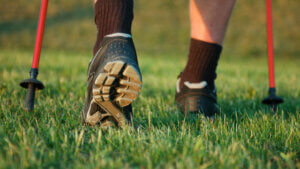An aid for healthy walking

Gillian Butcher c/o British Nordic Walking
The question posed is, are walking poles another fad? We could look a little closer at two common methods. I also welcome Gillian Butcher to consultingfootpain, who gave an interview for this article. She runs a local walking group my wife belongs to, so who better to ask as she is a trained Nordic Walking Instructor? Judging by the numbers of walkers ambling and rambling around the English countryside, walking is not going out of fashion anytime soon. The benefits of walking have been covered in another article by Taylor Downing, but those styles and use of walking aids might leave some readers confused.
Types of walking method
Nordic
This form of walking was derived from the ski pole in Finland, where poles were found useful during dry months without snow to make progress when walking. Alan Young provides a good insight into the background of the development of the Nordic style walker. While I use a strap holder for my poles around my hands, my wife Jill has a half or demi glove which clicks into the handle. The method is best observed in this YouTube video by Sikana (2017) narrated in British English (2’43”). Young and Butcher point out that 90% of your muscles are used than the 40% used in walking or running. What is not completely clear is whether this physical statistic represents trek walking as favourably.
Wendy Bumgardner (2020), writes for Verywellfit, suggests there are many advantages from Nordic walking; ‘…a 30-minute walk is a great antidote to the slouching many people do over desks and computers.’ As an author and writer, I find the fitness centre and walking help me as much as anything, but that does not mean Nordic offers any less benefit. Correcting posture by any mechanism will inevitably help upper body muscles like the trapezius. This is a sheet of muscles that straddles the neck and upper back and below the shoulders. With trekking poles, hikers use their upper body muscles they don’t ordinarily engage, like biceps, latissimus dorsi (back side muscles), pectorals, and triceps (Levy). It was time to ask Gillian her views on walking.
“Upright poles and hand straps provide the advantages offered by Nordic walking. The shoulder is opened up, and hands go behind past the hip giving forward propulsion. It is the push and engagement that involves more muscle activity,” she advises. When using trekking poles, she believes that you don’t get the same opportunity to put the effort behind the poles. I wanted to know how well Nordic poles fair when carrying a rucksack as Sean Nelson makes comments about carrying backpacks under trekking.
“So, does Nordic walking still apply and provide benefit when carrying a load on your back?” I asked Gillian.
“Definitely, it does, but it depends upon whether your arm swing is affected by this, disallowing that important upper body movement. Nordic walking can still work where there is a full arm swing.”
She points out that that the best swing method is often not used by walkers. “People see their arms moving forward but often forget that swinging back is equally as important.” This aspect is shown in the early video on the Nordic walking style.
Trekking
The angle of the poles and arms are different to Nordic walking. Trekking uses the arms at right angles while Nordic keeps the arms straight. Both methods aim to swing with rhythm. The pole goes forward when the opposite leg does. This pattern maximises balance and lets your arms swing the way they do naturally when hiking. As you step forward with your right foot, you plant the left pole forward by creating a cyclical rhythm. You will find out that you can literally push yourself forward with the poles. The smooth rhythm experienced by hikers reveals the benefits of walking, particularly when walking uphill. Walking with poles can help you establish and maintain that consistent rhythm which can increase your speed.
It is suggested that Nordic walking is valuable for the upper body. Measuring the energy output in calories was carried out in controlled conditions for Nordic walking, but no mention was made about comparisons. Watching the second video film (1’44’’), the narrator speaking through miserable weather and sees trekking poles differently. As a user of trekking poles, I cannot but agree that one major advantage is to reduce knee strain for me and keep me balanced when encountering uneven terrain. Going up gradients greatly benefits from using poles. There is a psychological and physical advantage. I notice my shoulders and back are exercised by keeping my posture straighter.
Sean Nelson talks about trekking poles which appeal to hikers, backpackers and day walkers, although many do not know how to use trekking poles to their best advantage. I like the analogy of thinking of poles as extra legs, Sean says. Most of the articles on the internet are informative and positive about the benefits to the body and even the terrain itself.
What about walking poles then?
Sets of fancy coloured walking poles have replaced wooden sticks for walking. Maybe this is a fad? We all like fancy designs. The question might be, When is a pole not a walking stick? This could be the subject of this article, but it isn’t. As a site dedicated to health, we need to tease out different walking styles. Is it the feet that make the style, or is it how we use those poles? Gillian says when Nordic Walking, you need to roll your feet to engage your calf and gluteal muscles. Then she points out she is biased and has not undertaken walking with trekking poles.
Fifty years ago, my father bought a lovely hazelwood stick during a family holiday in Scotland. This was capped at the top end with a bone antler. The V shape allowed comfortable hand grip. It looked smart, and it still is possible to buy wooden poles of this design today. The task of the stick for walking is rather different from the one used for those less, but non-disabled people.
Should we use one pole or two?
Seth Levy writes that most people favour two poles, but it does come down to preference and the nature of the trek activity. He also adds it depends if you are carrying heavyweight, like a backpack. Balance is always better with two poles than one. To start with, you have collateral balance and support. Next, you increase the base area around your body. This means that the centre of gravity will find it hard to fall outside your wider base. Falls in the elderly arise because of the inability to keep the centre of gravity inside the natural base. You can read my article on falls.
Gradients, terrain and inhibiting movement
Narrow paths, undulating ground, tree stumps and rabbit holes make a constant source for fouling poles when walking narrow tracks. Brambles, bracken, and ferns and any growth that lines paths upset the smooth cycle of pole walking. Gillian certainly advises doing what is comfortable when terrain makes heavy going. “Double poling can be used to push the body forward so that you walk through the poles placed at either side and held at 45 degrees.” I am probably more of a hauler when it comes to climbing, pushing my poles forwards, but that is more to aid an old injured knee.
Grips and gloves
Nordic poles doubtless have an advantage when it comes to hand grips and gloves. The poles can slide effortlessly backwards, disengage, slide back again, and make hand movements comfortable without losing the pole. The downside of gloves can be when going over styles or fences when you want to remove the pole. Gillian lent me some poles to try and this was not really a problem.
Health, stability and preventing falls
 As far as health is concerned, a walking aid provides stability by increasing support for the body under our feet. We could talk mechanics and the centre of gravity, but I want to keep the narrative simple. Suffice it to say; we want to ensure our main body weight (mass) does not move outside the support of our legs to prevent toppling. Let’s now move away from walking aids for those at risk of falling and compare the benefits of two types of walking movement. This is where we need to contrast trekking with Nordic walking. For many, it might seem using a pole, or a stick appears as a weakness. In fact, serious walkers benefit from such aids. Unlike father’s hazel stick used as a single aid when scaling the gradients surrounding Loch Tay in Perthshire, poles made from aluminium and carbon are preferred. When we reached the topic of design, Gillian believes carbon manufactured poles, although more expensive, are lighter, stronger, and as they can be made in one piece, they offer shock absorption. The retractable poles are more convenient for travelling. Some even come in 3 sections to reduce their length. Retractable poles are valuable if you need to make adjustments during the walk. This might include setting the lengths differently for different terrain. At the end of each pole, points or feet, depending upon the style and density of the terrain, can be used to benefit the ground stability. As technology advances, so do the materials and designs and the caps that prevent the pole from slipping.
As far as health is concerned, a walking aid provides stability by increasing support for the body under our feet. We could talk mechanics and the centre of gravity, but I want to keep the narrative simple. Suffice it to say; we want to ensure our main body weight (mass) does not move outside the support of our legs to prevent toppling. Let’s now move away from walking aids for those at risk of falling and compare the benefits of two types of walking movement. This is where we need to contrast trekking with Nordic walking. For many, it might seem using a pole, or a stick appears as a weakness. In fact, serious walkers benefit from such aids. Unlike father’s hazel stick used as a single aid when scaling the gradients surrounding Loch Tay in Perthshire, poles made from aluminium and carbon are preferred. When we reached the topic of design, Gillian believes carbon manufactured poles, although more expensive, are lighter, stronger, and as they can be made in one piece, they offer shock absorption. The retractable poles are more convenient for travelling. Some even come in 3 sections to reduce their length. Retractable poles are valuable if you need to make adjustments during the walk. This might include setting the lengths differently for different terrain. At the end of each pole, points or feet, depending upon the style and density of the terrain, can be used to benefit the ground stability. As technology advances, so do the materials and designs and the caps that prevent the pole from slipping.
The verdict
Energy expenditure as in calories
 When it comes down to burning off those calories well, any activity will increase energy expenditure. You need two ingredients. The effort against resistance is important, and hill-climbing is one method to achieve this. The other method is maintaining speed/velocity. Nordic and Trekking can use both, and you do not have to walk fast. However, it is clear from the systematic methods that constant rhythmic use of arms and legs about the pelvis will bring about good aerobic exercise, which inevitably benefits the cardiovascular system. I was not wholly convinced about the energy expenditure benefit being the sole domain of one method. Having joined Gillian for an induction I can say my money is now on the Nordic system because it is so driven by posture and technique. However, both methods will provide a good exercise workout and benefit the keen walker.
When it comes down to burning off those calories well, any activity will increase energy expenditure. You need two ingredients. The effort against resistance is important, and hill-climbing is one method to achieve this. The other method is maintaining speed/velocity. Nordic and Trekking can use both, and you do not have to walk fast. However, it is clear from the systematic methods that constant rhythmic use of arms and legs about the pelvis will bring about good aerobic exercise, which inevitably benefits the cardiovascular system. I was not wholly convinced about the energy expenditure benefit being the sole domain of one method. Having joined Gillian for an induction I can say my money is now on the Nordic system because it is so driven by posture and technique. However, both methods will provide a good exercise workout and benefit the keen walker.
Two walkers in the family
Once I converted from my own stout wooden stick, albeit not as smart as my father’s, I migrated to a pair of trekking poles. I don’t use them on the flat, while Jill can use her Nordic to better effect. Much of my experience comes from trial and error, but a couple I met in Cumbria on a walking holiday put me straight last year. I have now placed an order for Nordic poles having tried a set on lone from Gillian and feel good about my decision following my research.
A mixture of gym and walking is a great way to keep this 60-year-old body going a bit longer. It would appear to anyone reading between the two narratives that there is overlap. Smooth rhythm, less effort, and using upper and lower body muscles help recruit muscle activity. This redistributes weight beneficially, reducing overall strain. The build-up of forces would ordinarily be absorbed by the joints and muscles in the lower body alone, but the poles dissipate some of this. Trekking poles actually come with shock-absorbing properties that help some of the natural shock absorption, especially when descending gradients. Descents are the most dangerous time for knees and ankles. But the high % carbon poles are seriously lighter than anything I have had before and I also am persuaded by fixed lengths. It has been known to end a walk with poles at different lengths as they can slide down!
There is no right or wrong when it comes to walking styles, and both have benefits. When it comes to poles, the design must fit your requirements, travel, terrain, weight and decision to go telescopic over fixed. There is plenty to read on all aspects of walking, but in the end, you should do it for enjoyment and conduct walking safely and with respect for others and the countryside.
I am grateful to Gillian Butcher for her input, enthusiasm and vitality and hope to join her again soon.
Thanks for reading ‘Are Walking Poles another Fad?’ by David R Tollafield

Published by Busypencilcase Reflective Communications. Est. 2015
12th July 2021


Recent Comments